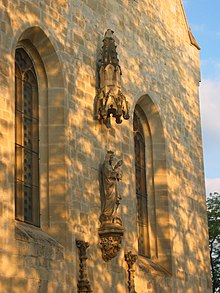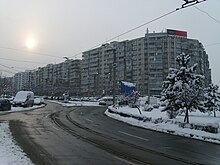Mănăştur
Mănăştur (German Abtsdorf or Transylvanian-Saxon Appesdorf , Hungarian Kolozsmonostor ) was the seat of a Benedictine abbey from the High Middle Ages until 1556 (hence the name). The surrounding village is since 1895 the district of Cluj (then Kolozsvár , Kingdom of Hungary , now Cluj-Napoca , Romania ). During the industrialization of the 1970s, Mănăştur was home to the city's largest prefabricated building district. The apartment blocks that have been built since the 1970s have covered almost all traces of the historic Mănăştur.
The district Grădinile Mănăştur (ung. Monostori kertek ) is usually added to Mănăştur.
history
In the middle of the 11th century a Benedictine abbey (Monasterium Beatae Mariae de Clus) was founded here. German settlers were called by the abbey in the 14th century and settled in its vicinity. By the end of the 16th century they emigrated to Cluj or were assimilated by the Hungarians. In 1890 about half of the 3,100 inhabitants were Magyars and half Romanians .
Since 1895 Mănăştur and Grădinile Mănăştur belong to Cluj-Napoca. After the old houses were demolished, the socialist residential area was built. The block S4 is the largest apartment block in Romania.
The preserved, today Roman Catholic Calvary Church was built in 1095, but has since been partially demolished several times. A new nave was built at the beginning of the 20th century. The restoration work in the 1990s was awarded the Europa Nostra Prize in 1998.
Origin of name
The abbot in the German place name and the monostor (dt. Monastery ) in Hungarian refer to the religious significance of the place. The Romanian Mănăştur is a translation of the Hungarian name and is pronounced similarly.
Infrastructure
About 120,000 people live in Mănăştur today. The busy national road DN1 , via which Cluj-Napoca can be reached from the west, runs through the middle of the district (as Calea Floreşti and Calea Mănăştur ). A tram compound and various O-bus - or bus -lines open up a large part of the neighborhood.
There are numerous shopping opportunities in large supermarkets, supplemented by the Polus Center Cluj (outside Mănăştur) and Winmarkt Someş . There are several green spaces in the district: Parcul Primăverii , Parcul Calvaria around the Calvary Church and the Iuliu Haţieganu sports park . The Agricultural and Veterinary University and the Ursus Brewery are also located here .
Individual evidence
- ↑ Árpád E. Varga: Erdély etnikai és felekezeti statisztikája (1850–1992) (as of September 20, 2009).


